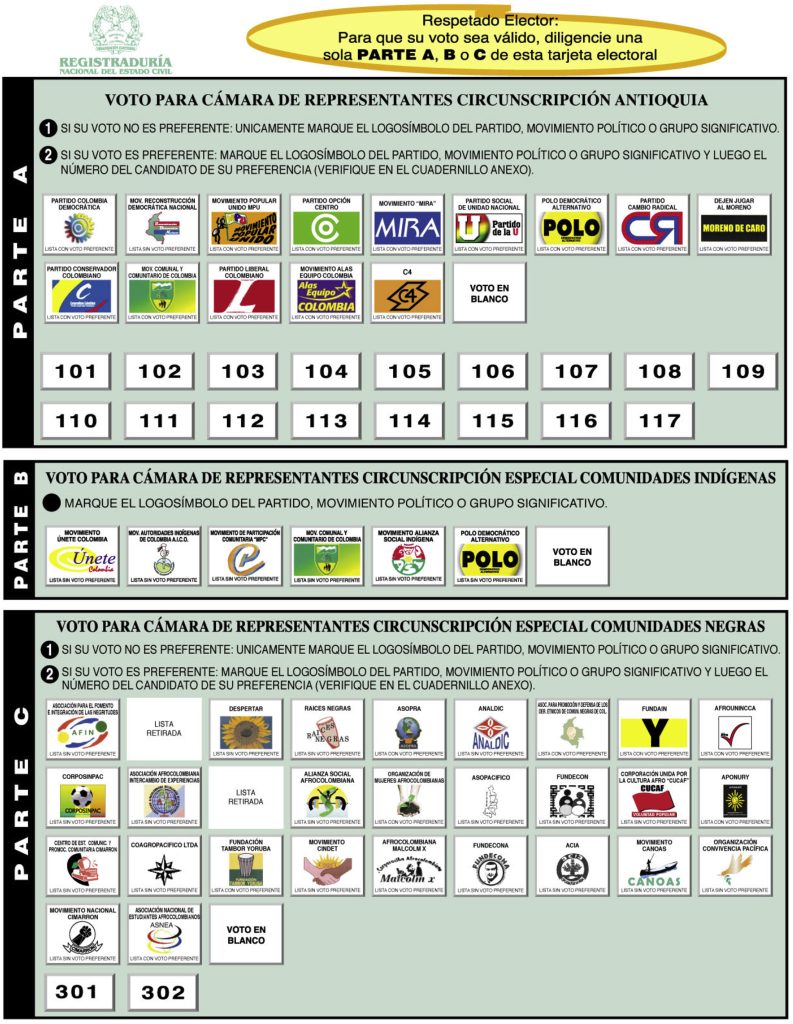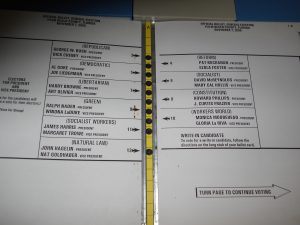2.3 Ballot Complexity
In some elections, voters are making multiple choices on the same ballot. Elections in the United States are an excellent example. In a general election, voters are electing officials for many different levels of government. The same ballot might include choices for President, Senate, Representative, Governor, School Board, County Commissioners, and more. There will also be a section of the ballot that is informational in nature, where voter instructions are indicated. Longer and more detailed ballots can take longer to count, and they can potentially confuse voters.
Measuring Complexity

If a ballot is confusing or if voter instructions aren’t clear, voters may place a mark on their ballot incorrectly, causing the ballot to be rejected. Some research from Colombia suggests that the confusing ballot design used in the 2006 and 2010 elections resulted in over 30% of ballots being rejected (Pachón et al., 2017). Once the design was improved for elections in 2011, the number of rejected ballots decreased by 38%.
When voters place more markings on the ballot than are required, it is known as an overvote. Assessing the frequency of overvotes can reveal a potentially confusing ballot design. Similarly, confusing ballot design can result in undervoting. An undervote occurs when a vote was not cast in a particular race or a section of the ballot was left blank. This can happen with complex ballots that require voters to make multiple selections or mark the ballot in several areas. Disproportionate frequencies of undervotes can also be indicative of a confusing ballot design.
Spoiled Ballots
When a voter deliberately marks a ballot incorrectly, this is known as a spoiled ballot. Voters may do this as a form of protest or to express dissatisfaction with the election process. Spoiled ballots are not counted.
Examples of Confusing Ballots
The choice of ballot design can have real-world consequences. It’s possible that a confusing ballot design can result in enough undervotes or overvotes to influence the election results.

Overvotes in Florida
In the 2000 United States general election, voters in Palm Beach County cast votes using a butterfly ballot. In this country, there were over 19,000 overvotes, which was unusually high for the state of Florida. Of those 19,000 votes, 80% were intended as votes for Gore, who ultimately lost the vote tally in Florida by 537 votes. Some researchers attribute the erroneous overvotes to the confusing ballot design (Agresti & Presnell, 2002).
Undervotes in Florida
In the 2018 midterm elections, Broward County in Florida used a ballot design that placed voter instructions in the same column as a key Senate Race. As a general practice, voter instructions are usually placed in their own column or separate area of the ballot to avoid confusing voters. This unusual placement may have led to approximately 25,000 undervotes in a race that was decided by 11,000 votes (Morse et al., 2024).
Bizarre Ballots
Despite having a simple ballot design, some Canadian elections produce ballots that are unusually long. In the 2025 Canadian federal election, there was a coordinated effort by activist groups to flood a riding with candidates. 91 candidates registered to run in the riding of Carleton as a form of protest against Canada’s electoral system. The resulting ballot was almost one meter long!

Because of the length, Elections Canada used a two-column design for this riding and adopted a modified counting procedure (Elections Canada, 2025 April).

